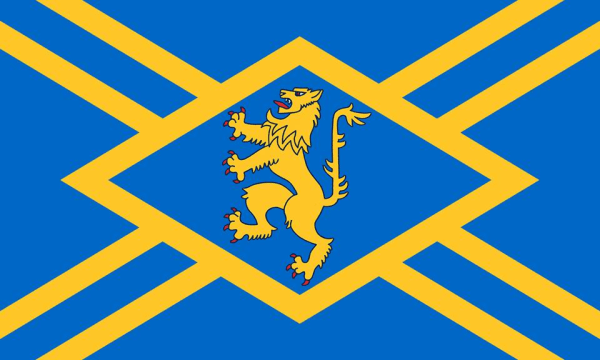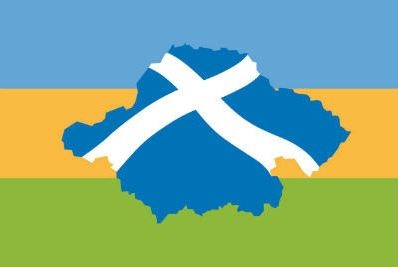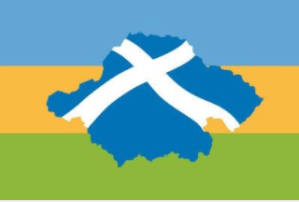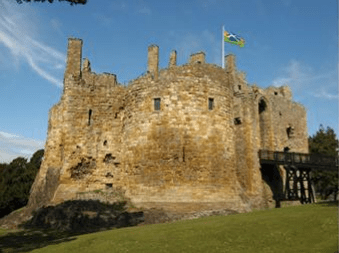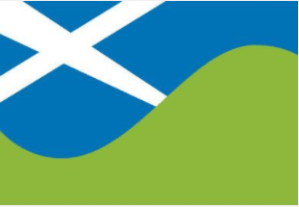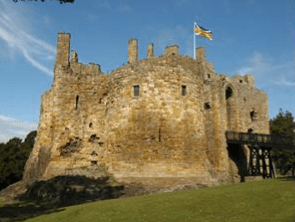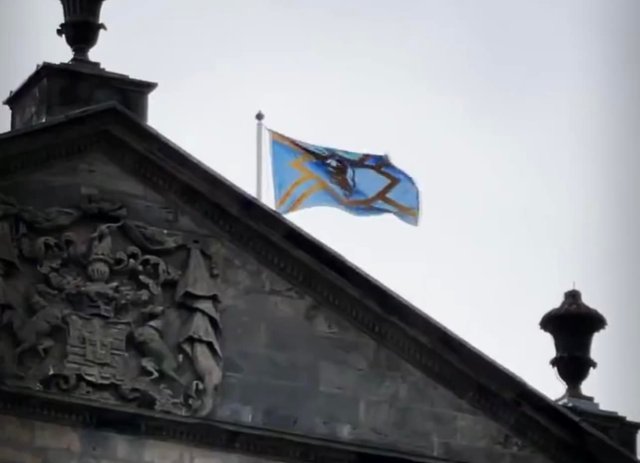The East Lothian flag was revealed on December 13th 2018

at a reception hosted by the Lord Provost. The registered design was created by local man, Archie Martin, who worked at East Lothian council for twenty three years as a landscape architect and was the winner of a competition to select a county flag, launched in late November 2017. A total of 1,532 votes were cast.

East Lothian Provost John McMillan said: “It was an emotional evening and an absolute privilege to be there at the announcement of the wonderful winning design. I think this is a simple yet eye catching design which I hope will very quickly become a strong symbol of East Lothian and adopted by groups and residents for many years to come. It was very sad that Archie, a very much loved and missed former council employee, could not have been there to hear that his design had come out top of a very tough competition but I’m delighted that his family were so pleased with the news.”

Lord Lyon Joseph Morrow, above left, presenting the flag with East Lothian Lord Lieutenant Michael Williams, said: “It’s an honour to be with the people of East Lothian to celebrate this cairn in their history with the choosing of such a strong image of a flag to represent the qualities of the district, but above all the spirit and pride that people have in their area. I congratulate the winner of the competition and send my best wishes to his family and to all who participated in this cairn building exercise. I look forward to recording the flag in the historic register of the Lyon Court.”
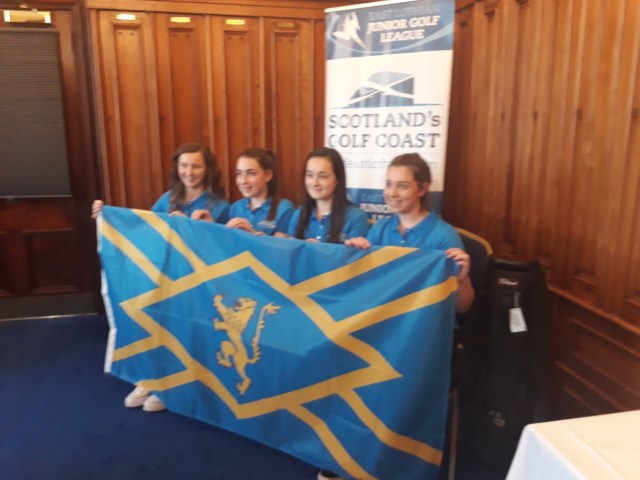
David Williamson, Chair of the Scottish Flag Trust, said: “The Scottish Flag Trust initiated the idea of a design competition for a civic flag for East Lothian in the summer of 2017, and we are delighted to see it come to fruition. What has been most heartening has been the high level of community buy-in throughout, both during the design phase in which hundreds of entries were submitted, and during the voting phase in which record numbers of the public took part. I think everyone can be pleased with Archie Martin’s distinctive flag design which attracted a clear majority of votes.”
The flag is seen below wielded by Philip Tibbetts, “Honorary Vexillologist” to the Court of the Lord Lyon.
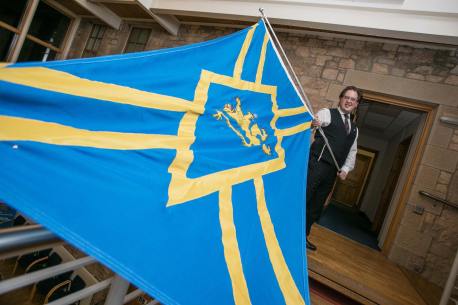
The venture was organised jointly by East Lothian Council and the Scottish Flag Trust, in association with local newspaper East Lothian Courier, under the auspices of the Scottish heraldic authority, the Lord Lyon.
Seen below, launching the competition, are

at left, Dave Williamson, of the Scottish Flag Trust; Michael Williams, Lord Lieutenant of East Lothian to his right; Joseph Morrow, Lord Lyon and at far right, Provost of East Lothian, John McMillan.

Commenting on the launch, Councillor John McMillan, Provost for East Lothian, said: “Having a distinctive new civic flag for East Lothian will allow individuals and groups across the county to express pride in their local community, to celebrate their heritage and help raise recognition and awareness of East Lothian nationwide. I think this competition will capture the imagination of many people and will attract a great deal of interest from across the county, as well as further afield. I’m particularly keen for our schools to get involved too and I very much look forward to seeing all the entries as I’m sure they’ll be varied and inspiring.”
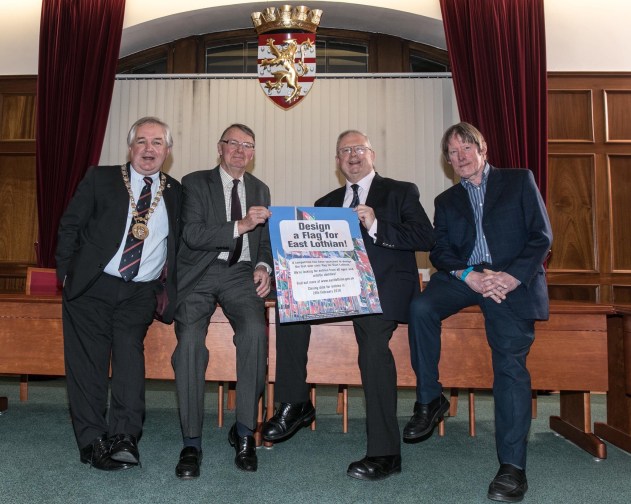
Michael Williams, Lord Lieutenant for East Lothian, observed that: “East Lothian is a very unique place and it is important that the county has its own flag. I am very interested to see what people come up with.”
Dave Williamson, chairman of the Scottish Flag Trust, added: “What makes this initiative particularly special is the collaborative working between East Lothian Council and the Scottish Flag Trust, along with the support and guidance of the Lord Lyon. We are hopeful that this competition, followed by a public vote, will deliver a new flag that will reflect the county and be welcomed by everyone.”

The competition ran through February 2018, closing on the 28th. It received a whopping 623 entries, from as far afield as the USA and New Zealand.

Councillor John McMillan, East Lothian Provost, said: “I am absolutely overwhelmed that we received so many entries of such a high standard.
“We will be in touch with everyone who took the time to submit a design in due course and the public vote will be launched soon. I hope as many people as possible will vote for their favourite so we can have an East Lothian flag to be proud of.”
David Williamson, chairman of the Scottish Flag Trust, added: “The response to the competition has been tremendous, especially from East Lothian schools, so a big thank you is due.”
Four final designs
were selected from this vast array of submissions, by a panel
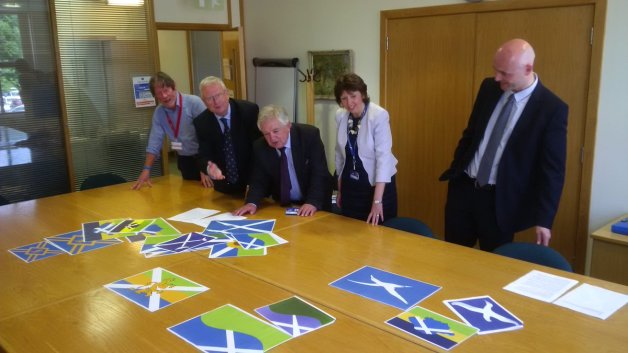
comprising the Lord Lieutenant of East Lothian, Michael Williams MBE; Lord Lyon Joseph Morrow; East Lothian Council Provost John McMillan and Chief Executive Angela Leitch; David Williamson, Chair of the Scottish Flag Trust and Robbie Scott, Editor of the East Lothian Courier, at Haddington on the 8th of June 2018. The four finalists were entered into a public vote which ran until the end of August.
East Lothian Council Provost John McMillan, said: “It was a very difficult decision for the judges, having to choose four final designs from the huge number of high quality submissions we received. I hope that East Lothian residents will get involved again and let us know what their favourite design is. Having a distinctive new civic flag for East Lothian will allow individuals and groups across the county to express pride in their local community, to celebrate their heritage and help raise recognition and awareness of East Lothian nationwide. I will be very excited to see the outcome of the public vote.”
David Williamson, Chair of the Scottish Flag Trust, said: “Experience elsewhere suggests that involving the public in choosing a civic flag is by far the best way to progress, and the hope is that the interest already shown in the East Lothian competition will continue into the voting stage. Voting on the four short-listed flag designs has been held back until after the main holiday period, so that people don’t miss out on the chance to participate.”
Lord Lyon Dr Joseph Morrow said: “It was an exciting task to take part in the East Lothian flag competition. There was a wealth of talent expressed in the entries which reflected on the area. I now look forward to the vote of the people and the taking of the ownership of flag to be a symbol of pride in East Lothian.”
Regrettably the four chosen designs did not present best design practice, as outlined here. Specifically, the judging panel exhibited a very limited design remit; whilst the choice of colours evident in this selection, blue for sea, yellow for a sandy beach, green for land, is not inappropriate, it was a trite and tired option. Which territory on Earth with a shoreline, could not be represented by such colours? What do they say directly about East Lothian that could not be representative of Fife, for example, or Argyll perhaps? If these colours must be used, one might hope for a more imaginative arrangement than a tricolour of stripes, there being already, quite a few flags with stripes in the world! Is a green, yellow and blue tricolour something that is going to stand out? The winning design, was really the only viable option.
The voided gold saltire, on blue, reflects the local birthplace of the national flag,


The blue stripes through the gold are also intended to represent the county’s rivers Esk and Tyne, with the gold colour signifying the wealth of East Lothian’s farmlands and reputation as the granary of Scotland and recalling the traditional sun symbol of the Lothian region, detailed further below.
The lion rampant, is taken from the arms of the East Lothian Council

, included there in token of King William “the Lion” and found on the arms of local nobility such as the Earl of Dunbar

However, whilst a recognised, national, symbol, it is questionable whether a lion rampant specifically evokes East Lothian as a county? Although rampant lions have certainly appeared on the arms of local nobility and the local authority, the county is associated with several more locally resonant devices, a blazing sun; a goat; a goat and ivy combination; a peregrine falcon, as appear on the sample of rejected designs shown below. The lion is palpably not unique to East Lothian and it is not remotely distinct, lions appear across Scotland, the UK, Europe and the World.

The whole design thus presents a rather generic arrangement, with a “Scottish feel”, comparable to the flag of Nova Scotia,
recalling its Scottish roots.
Let’s take a look at the other three finalists. No criticism is intended towards the designers, they are to be applauded for conjuring up ideas and participating but one can genuinely question the thinking of the judging panel who seem to have been unaware of the recommendations on good flag design, as can be found here and here.
Design B
featured a map, which usually denote territories in dispute, as a neutral design, avoiding symbols or emblems of the sides in dispute, for example, Cyprus, Kosovo
Kosovo 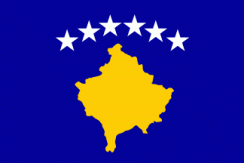
and the joint Korean Olympic flag
 No such issue applied here and moreover, the map was of the council’s administrative remit, NOT the actual county of East Lothian, so could not be considered representative of the actual county of East Lothian. And, when viewed from any distance, this map shape would appear as a coloured blob and thus be essentially meaningless.
No such issue applied here and moreover, the map was of the council’s administrative remit, NOT the actual county of East Lothian, so could not be considered representative of the actual county of East Lothian. And, when viewed from any distance, this map shape would appear as a coloured blob and thus be essentially meaningless.
Inclusion of one flag on another was an extra complication. Many English county flags have used the form of a cross of Saint George as the basis of a flag but none of them have that actual flag as part of the local design. As a Scottish county, East Lothian might opt to deploy a saltire form in its flag, there are a number of such proposals for other Scottish counties, shown on these pages and of course, East Lothian is the acknowledged birthplace of the Scottish saltire, so a nod to the national flag is an obvious and very relevant element to include but ideally such designs should fashion a saltire in locally meaningful colours or bearing distinct local devices, as found in the sample of rejected designs shown below; simply repeating the national flag is a dull, pedestrian approach and the panel sanctioned depiction was crude and cartoonish. It was never likely to raise passion or inspire a firm local identity.
Whilst Flag C
appeared to be a depiction of a green hill with the Scottish saltire beaming out into the sky from one side, the blue actually symbolised the sea; would anyone have recognised this without being so advised? Again, use of the national flag on a local one, as described, emphasises nationality rather than locality, the local symbolism is not obvious. Imagine this flag flying thirty feet in the air, fifty feet away, would its design or symbolism be evident?
 Flag D had the potential of being a fair design. Notwithstanding the unimaginative choice of colours, a saltire and stripes
Flag D had the potential of being a fair design. Notwithstanding the unimaginative choice of colours, a saltire and stripes

is a simple combination, which makes dull stripes more interesting, and lends the national symbol something of a local flavour. The best flags are kept simple, such a design could be easily drawn by hand and be fairly easy to discern from any height or distance. Unfortunately a lion rampant was added to the mix. Whilst this arrangement might look attractive on a static page or screen it would not translate well when flapping in a gust or hanging limply, the more details there are, the less identifiable it is. When in flight, thirty feet high, fifty feet away, the lion, again, would just look like a blob against the other colours.
Many people designing flags fall into the trap of throwing everything they can think of into the arrangement, failing to recognise that less is more; the simpler the design, the more discernible it will be, the more eye catching it will appear. And again, whilst, as described, the lion rampant is an obvious, national symbol, its specific local symbolism is not obvious. As with the winning design, this is a generic Scottish arrangement, that does not immediately shout East Lothian and again resembles the Scottish themed flag of Nova Scotia
specifically intended to reflect that territory’s Scottish origins. A further flaw with Design D is that it flouts the rule of tincture, an originally heraldic “rule” that serves to enhance visibility by keeping dark colours, blue, black, red and green, separate from light ones, yellow and white. Thus a blue charge is visible against a white or yellow background but barely seen against a black one, for example. Design D placed a yellow lion, against a white cross, against a yellow central stripe, flouting the recommendation twice; its visibility would be very limited, especially when in the form of a cheaply made, budget flag, which are the vast majority of flags flown.
Over 600 hundred entries were submitted to the competition, yet the judging panel chose four very similar, insipid finalists, in direct contradiction to the comment of Councillor John McMillan, at the launch of the competition, who, referring to expected submissions stated “’I’m sure they’ll be varied and inspiring.”. For true and meaningful choice the finalists ought to offer something different to voters, a set of real options. For comparison, the finalists in the Black Country flag competition,

were six very distinct and varied designs. presenting a real choice to voters.
There is a glaring disparity between the very similar, final four designs in the competition and the widely varying range of submissions received.
One design
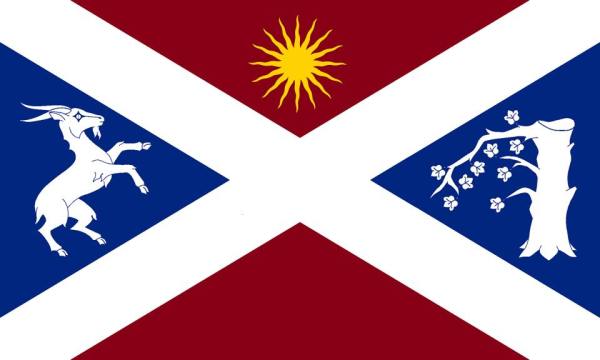
included the St Andrew’s Cross referencing Athelstaneford, in the county, the birthplace of the national flag. Also present on the design are a goat and an ivy tree from the arms of the county town, Haddington

The goat and ivy tree have also historically represented the county as a whole. Here, appearing as the badge of the Haddingtonshire Rifle Volunteers.

Use of the goat and ivy combination as a viable emblem for inclusion on any potential East Lothian county flag was in fact advocated in the council’s official guidelines to the competition
A single goat also appeared on the seal formerly used by Haddingtonshire County Council

The maroon colour in the flag, was used as the corporate colours of the former Lothian Regional Council and is also found in the livery of the local bus operator

A golden sun appears, as one theory holds that the name Lothian may derive from the name of the Celtic God of Light, “Lugus”. Accordingly, the symbol of a sun appeared on the arms of the Earldom of Lothian

and featured in the arms of the Lothian regional council

Another submission

reworked some of these themes in a different arrangement and included a depiction of a Peregrine Falcon in flight, in a contrasting blue, as used by East Lothian council,

and consequently recognised as a local emblem; it is held “to convey admirable traits of strength and dynamism and reflects East Lothian’s laudable success as the home of colonies of this protected and majestic species” Use of the peregrine as a viable emblem for inclusion on any potential East Lothian county flag was in fact advocated in the council’s official guidelines to the competition

A third submission
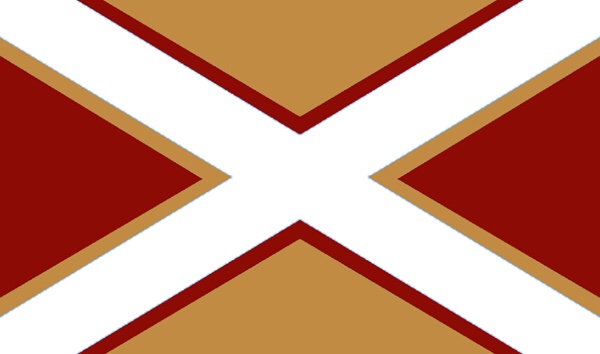
again utlised the local maroon colour, as used by the transport company

fashioned in the form of a saltire, again to reflect the county’s recognition as the birthplace of the Scottish flag.
Another resplendent design
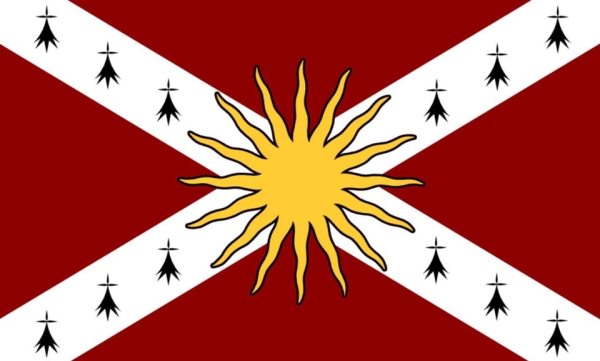
had been proposed several years previously. It again utilised the locally deployed maroon colour scheme combined with a white saltire, in recognition, as described, of the locality’s status as the home of the Scottish national flag and a bright burning sun, again derived from the arms of the Dukedom of Lothian and the former Lothian Regional Council, seen above. An ermine pattern featured on the arms of the cross recalling the ermine bands found in the arms of the local county council
 which in turn derive from the arms
which in turn derive from the arms
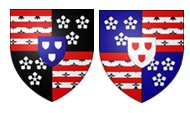
used by the Giffords of Yester, a family given lands in East Lothian, by King William the Lion (1165-1214).
A further series of submissions to the competition focused on the saltire’s origin in the county, with a variety of diagonal cross designs in different colour schemes. The first

features a gold saltire against a mainly blue field but with the lower triangle in green to represent “an upward progress to a bright and hopeful future”. Blue also reflects the county’s sea and coastline, yellow its golden sands and its lush green fertile countryside. Another features a field of seven horizontal stripes,

taken from the East Lothian Council’s Coat of Arms, seen above. Blue reflects the county’s sea and coastline, white was described as representing fortitude and red, valour. A third design

has purple for diversity and is an echo of heather and thistle and green, as detailed previously. A fourth submission

was intended to reflect the colours used by the the local council, with the blue from the the national flag and verdant green for the lush countryside.

A final design again features a striped field, recalling the pattern of the council’s arms, in two blue shades, referring to the varying realisations of the blue field in the Scottish national flag.
The newly registered county flag of East Lothian

is presented below

by some council employees and friends on Mount Kilimanjaro in aid of Cancer Research UK. It is seen below

flying over Lammerlaw in the county and here
flying over Yester House, Haddington.
The county flag is available to buy here
Useful Links

